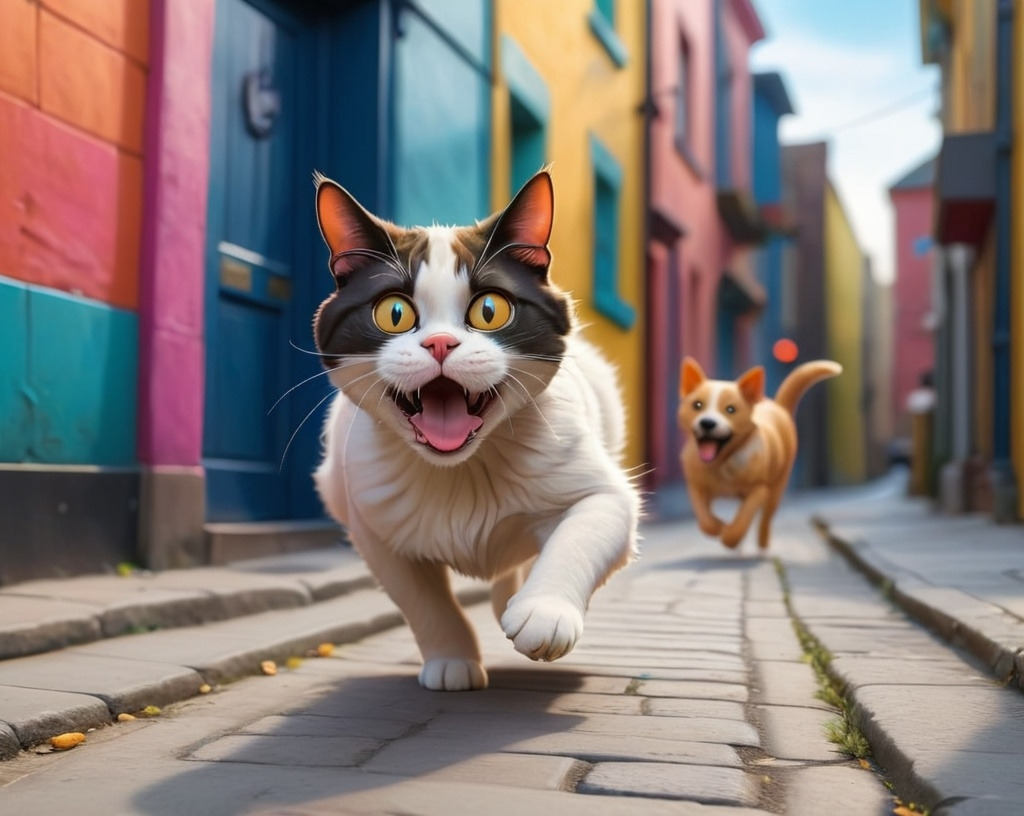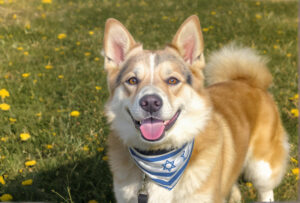
Why Do Dogs Chase Cats?. This behaviour is not just about the thrill of the chase; it’s deeply rooted in the evolutionary history of dogs as scavengers and hunters. Their bodies are built to notice movement, making them prone to chasing any moving animal, including cats.
The instinct to chase is an expression of their predatory drive, a trait that has been honed over centuries. This natural behaviour is not specific to cats; dogs will chase any fast-moving object or animal that triggers their hunting instinct.
Understanding this behaviour can help pet owners manage their dog’s interactions with other animals and reduce the risk of conflicts.
- The Evolutionary History Behind Dogs Chasing Cats
- Understanding the Basics of Dog and Cat Interactions
- Understanding Your Dog's Chase Motivation
- The Feline Perspective: How Cats React and Why
- Case Study: The Thompson Family's Dog-Cat Integration Success
- Creating Harmony Between Your Canine and Feline Companions
- FAQ
The Evolutionary History Behind Dogs Chasing Cats
Dogs chasing cats comes from their ancient past. This behavior is rooted in their ancestral instincts. Dogs were bred for hunting and guarding.
Dogs have a strong prey drive from their wild days. This drive makes them chase cats.
Ancient Canine Hunting Instincts
Dogs’ wild ancestors were hunters. They chased and caught prey to survive. This hunting instinct remains in many breeds today.
- High energy breeds like Border Collies and Australian Shepherds have a strong herding instinct.
- Breeds such as Greyhounds and Whippets are known for their speed and were bred for chasing small game.
Predator-Prey Relationship Development
Dogs and cats have always had a predator-prey relationship. Dogs chase cats because of their prey drive.
This relationship was shaped by their environments and roles in their ecosystems.
Modern Domestication Effects
Domestication hasn’t erased dogs’ ancestral instincts. But, modern breeding and training have changed how they act.
Some key factors include:
- Breeding practices that have altered the intensity of prey drive in various breeds.
- Training that can either exacerbate or mitigate the tendency to chase cats.
Understanding the Basics of Dog and Cat Interactions
When it comes to dog and cat interactions, understanding the basics is key. Dogs and cats have different personalities and behaviour’s, which can impact their interactions. It’s important to recognize the signs of predatory behaviour in pets and take steps to prevent it.
Dogs and cats have unique instincts and behaviors that can influence their interactions. Dogs, being pack animals, may exhibit behaviors such as chasing, barking, and play-fighting. On the other hand, cats are generally more independent and may display behaviors like hissing, growling, and swatting.
Recognizing the signs of predatory behavior in pets is essential to ensure their safety and well-being. Dogs may exhibit behaviors such as stalking, pouncing, and chasing, while cats may display behaviors like stalking, pouncing, and swatting. These behaviors can be triggered by various stimuli, including prey-like toys or even other pets.
To prevent predatory behavior in pets, it’s important to provide them with appropriate outlets for their natural instincts. This can include providing toys that mimic prey, such as feather wands or laser pointers, and engaging in play that encourages natural hunting behaviors. It’s also important to supervise interactions between dogs and cats to prevent any harm or aggression.
By understanding the basics of dog and cat interactions and recognizing the signs of predatory behavior, you can create a safe and harmonious environment for both pets. Remember to provide them with appropriate outlets for their natural instincts and supervise their interactions to prevent any harm or aggression.
Recognizing the Signs of Predatory Behavior in Pets
Recognizing the signs of predatory behavior in pets is important to ensure their safety and well-being. Here are some common signs to look out for:
- Stalking: Dogs and cats may exhibit stalking behaviors, such as crouching low to the ground and moving stealthily.
- Pouncing: Dogs and cats may display pouncing behaviors, such as jumping up and down or swatting at toys or other pets.
- Chasing: Dogs and cats may exhibit chasing behaviors, such as running after toys or other pets.
- Growling: Dogs and cats may display growling behaviors, such as low, rumbling sounds or raised hackles.
- Hissing: Cats may exhibit hissing behaviors, such as releasing air through their mouth to deter predators.
- Swatting: Dogs and cats may display swatting behaviors, such as hitting or swiping at toys or other pets.
By recognizing these signs of predatory behavior, you can take steps to prevent it and ensure the safety and well-being of your pets.
Understanding Your Dog’s Chase Motivation
To understand why dogs chase cats, we must explore canine behavior and psychology. This complex behavior is shaped by instinct, environment, and breed characteristics.
Prey Drive vs. Play Behavior
Dogs chase cats mainly because of their prey drive. This instinct to chase and catch is rooted in their evolutionary past. It’s triggered by the sight, sound, and movement of cats.
On the other hand, some dogs chase cats as a form of play behavior. This is shown by their energetic and playful actions. They often invite the cat to play.
| Characteristics | Prey Drive | Play Behavior |
|---|---|---|
| Motivation | Innate instinct to chase and capture | Desire to engage in playful activity |
| Body Language | Focused, intent, and often predatory posturing | Relaxed, energetic, and inviting |
| Response to Cat | Pursuit and possible capture | Invitation to play, possibly with retreat or playful gestures |
Breed-Specific Tendencies
Some dog breeds are more likely to chase cats due to their history. For example, Sighthounds and Terriers were bred for hunting. This makes them more inclined to chase.
Environmental Triggers
A dog’s environment greatly influences their behavior towards cats. Socialization, training, and exposure to cats can either increase or decrease chasing tendencies.
A dog well-socialized to cats from a young age is less likely to chase. This is compared to a dog with limited or negative exposure.
The Feline Perspective: How Cats React and Why
Cats have a unique way of reacting when dogs chase them. This is due to their instincts, environment, and past experiences. Their natural predatory behavior and the way they interact with dogs greatly influence their reactions.
When a dog chases a cat, the cat feels scared and acts on instinct. They might run away, stand their ground, or freeze. The difference in cat and dog behavior is key in these situations.
- Rapid flight, attempting to outrun the dog.
- Defensive posturing, such as hissing or growling.
- Seeking higher ground or a safe place to hide.
It’s important for pet owners to understand these reactions. This knowledge helps them manage how dogs and cats interact. By spotting signs of stress and fear in cats, owners can step in and prevent harm.
The environment also affects how cats react. Cats that grow up with dogs may be less scared. But those who don’t meet dogs often might react more strongly.
To have a peaceful home, it’s vital to consider both dogs and cats’ needs. By doing this, owners can lessen chases and help their pets live together better.
Case Study: The Thompson Family’s Dog-Cat Integration Success
The Thompson family’s journey to integrate their dog and cat is a great example of successful pet cohabitation. They faced challenges but found rewards in creating a harmonious home with multiple pets.
Initial Chase Problems
The Thompson family first faced big challenges. Their dog and cat chased each other aggressively. The dog, with a strong prey drive, chased the cat, stressing both animals.
The cat felt scared and threatened, hiding or becoming defensive. This made their home tense.
Implementation of Training Methods
To solve these problems, the Thompsons started a detailed training program.
Separated their pets and then introduced them slowly under controlled conditions.
Used positive reinforcement like treats and praise to encourage calm behaviour.
They also worked on reducing the dog’s prey drive over time.
Observable Behavioral Changes
As training went on, the Thompsons saw big changes in their pets. The dog became less reactive to the cat. The cat felt safer, hiding less.
Their home went from tense to peaceful. The dog and cat learned to live together. They even showed signs of friendship, like playing or resting together.
Creating Harmony Between Your Canine and Feline Companions
Understanding why dogs chase cats is key to a peaceful home. Knowing the reasons behind this behavior helps you manage your pets better.
Introduce dogs and cats slowly and in a safe space. Give each pet their own area and manage resources to reduce fights.
Positive reinforcement training works well. Reward your dog for calm behavior and ignore or redirect any chasing. This teaches them it’s not okay to chase cats.
With patience and the right training, dogs and cats can live together peacefully. By tackling the reasons behind chasing, you can improve their relationship.












